
Privately Owned
The two pavilions date from the 1620’s, and with parts of a curving colonade are all that is left of a large house with wings. One pavilion contained a chapel, the other a library. They are among the earliest examples of Palladian architecture in England. These are attractive buildings. Access is limited to a few days in August, and requires payment of a small fee. I remember having to drive down a long narrow lane avoiding the paintball site, waiting till the opening time, and knocking at the door of the keyholder’s cottage, and I think I was the sole visitor that afternoon. On the second visit (Aug 2012) it was open and there were other visitors and a friendly gardener. You can go inside the left-hand (ballroom) pavilion.
Various buildings from the original estate exist, under separate ownership and converted for residential use.
Pavilion L is now a wedding venue.
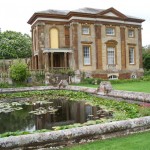
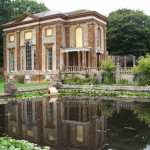
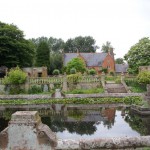
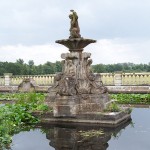
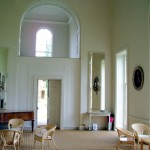
Category: Midlands
location
Boughton House, Northants.
An imposing house “The English Versailles” notable for looking a bit like a French palace. The contents include fabulous treasures – a large collection of fine art including paintings, furniture, porcelain, weapons, textiles, claiming to be one of the major treasure houses of England. It has seven courtyards and a wing which remains as an unfinished shell, revealing details of the construction. The gardens and estate are also notable. The 17th century design features of the gardens are being restored. The house is open during August and a few other dates, the gardens more often. Suggested visit time: at least a half day.
Cottesbrooke Hall, Northants
A Queen Anne house in extensive grounds. Two flanking pavilions are joined to the main house by curving corridors. There is a noted collection of sporting pictures. If I remember correctly, the house is notable for being exceptionally well maintained: everything inside looks like new. The house is open to visitors on limited dates during the warmer months, and admission is by conducted tour.
Deene Park, Northants
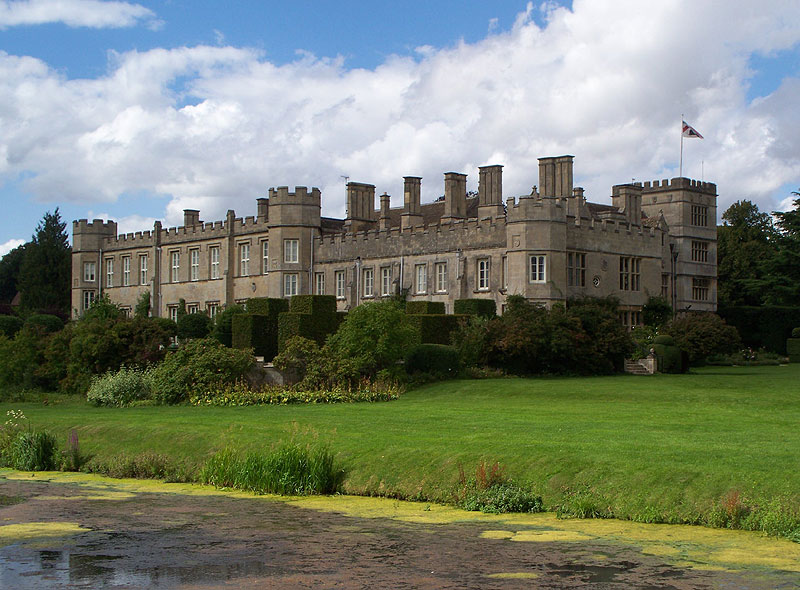 Private
Private
A substantial house, with crenellations, and built of honey-coloured stone around a central courtyard. The earlier parts date from the 16th centurey or earlier, with 18th and 19th century additions. The contents include relics of Lord Cardigan of Balaclava fame, and of the scandalous Adeline Horsey de Horsey. The house is open on limited dates during the summer months.
The contents are of considerable interest and rooms downstairs and upstairs are opened for visitors.
The grounds are worth seeing and include a number of feature garden areas as well as woodland walks and an expanse of lawn. Not accessible to visitors are the former walled gardens and an intriguing circular building.
If you want a leisurely visit to the house, the grounds, and the tea-room you are advised to arrive soon after the grounds open as the total opening time is only 4 hours.
If using satnav, look for brown car park signs, as the satnav may direct you to a back entrance by a longer route.
Note that there are other grand houses in the Corby area which could be visited on the same day. Kirby Hall is nearby.
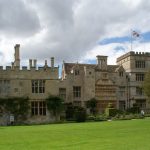
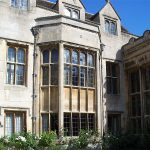
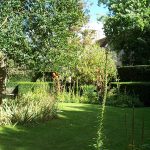
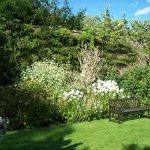
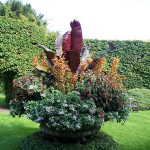
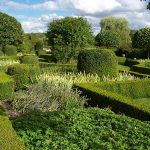
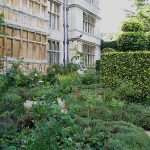
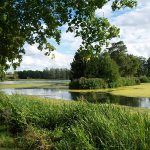
Harrington Airfield, Northants
During the war, the airfield was the base of the USAAF 801st and 492nd Bomb Groups, and the USAAF’s clandestine “Carpetbagger” operations. Carpetbagger operations delivered supplies and personnel to resistance groups in occupied countries. Later, it became a Thor missile base.
Today, the runways have been returned to agriculture. On the site of the original buildings the Carpetbagger Aviation Museum can be found. This crowded museum contains many exhibits related to Carpetbagger. If you a military aviation buff, you should find this of great interest.
In the surrounding countryside a few concrete relics and a memorial can be found. The memorial is on the C-47 dispersal site at the side of the Lamport – Harrington Road.
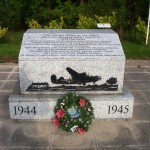
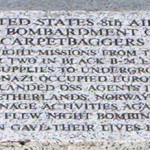
Lyveden New Bield, Northants
National Trust
An abandoned and incomplete Elizabethan building, with its surrounding gardens. The building, a shell, is interesting, and when I visited the orchard had been re-created with a planting of period fruit trees.
Re-visited 28 Aug 2021 (10 years later). The manor house (acquired 2013) and a new car park were opened earlier this year. The new car park is further from the Lodge, and a walk from car park to Lodge takes one to the manor house which houses a cafe, toilets, and an upper floor exhibition room (the latter not open when I visited). From there one can walk onwards to the orchard and the house, past some mounds and long ponds. I didn’t see the labyrinth marked in the grass in the area enclosed by mounds and long ponds – apparently it is clear cut in late summer. The stonework of the Lodge is in remarkably good condition, and various carved religious symbols decorate the exterior. Inside, one can enter the basement rooms and look upward to the sky. In the manor house I saw a model showing what the Lodge would have looked like if completed.
Naseby Battlefield, Northamptonshire
There isn’t much for the casual visitor to look at, but if you are interested in Civil War history, you can arm yourself with a map, and drive or tramp around, visiting the various view points and seeing for yourself the terrain where the armed encounters took place.
I read that plans have been approved for a £3M. visitor centre at the site.
Sulgrave Manor, Oxfordshire.
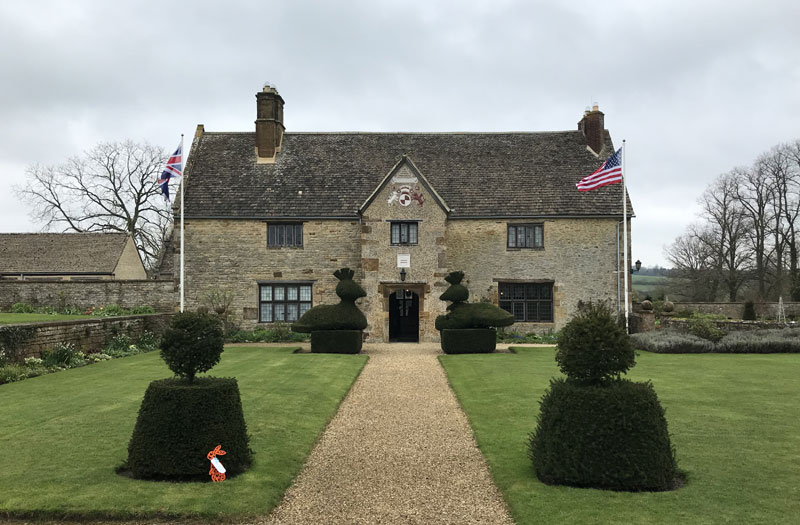 Private (HHA)
Private (HHA)
Mainly notable as the ancestral home of the Washingtons (=American president) in Britain, the manor was restored in the 1920’s as a symbol of British-American friendship. The original house was built by one Lawrence Washington in the 16th century. John Washington, Lawrence’s great-grandson, emigrated to the United States. By this time the manor had already passed into other hands. A descendant of John Washington became the first President of the United States.
Subsequent owners added on or demolished various parts, with the great Hall and the chamber above it being the oldest surviving parts. The wing completing the symmetry of the frontage is a 1920’s addition built to house caretakers of the restored house and gardens.
The house contains representative old furniture and artefacts. The grounds were laid out in the 1920’s when the house was restored. There is also a collection of George Washington memorabilia.
When visiting, if you drive through the village, look for the Sulgrave Manor entrance on your right, at the end of the village. Do NOT turn left into Manor Lane, as your satnav may indicate.
All photos 2024
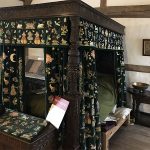
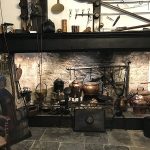
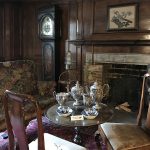
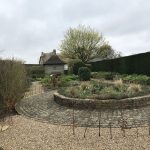
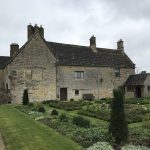
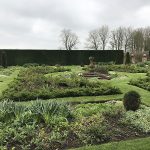
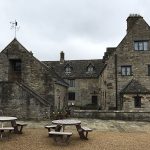
Upton House, Warwickshire
National Trust.
Visited c. 2005
While the house is old in origins, it has been updated a number of times and it’s the contents and gardens which are notable. It contains a major collection of paintings and porcelain, including Old Masters. To the rear are the magnificent gardens, which descend by terracing towards water. There is also a kitchen garden. Allow for a half-day visit.
